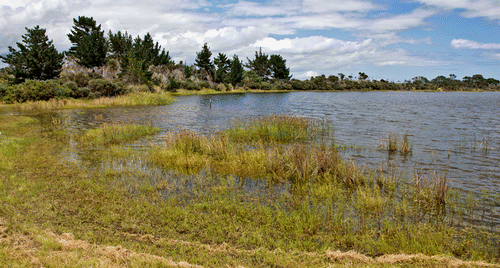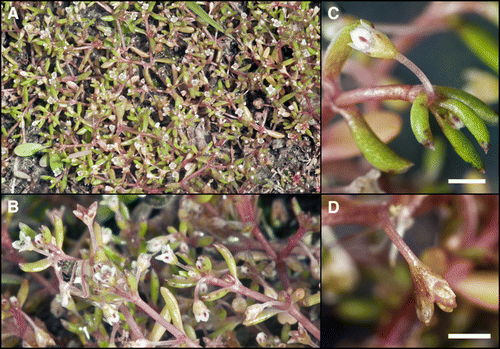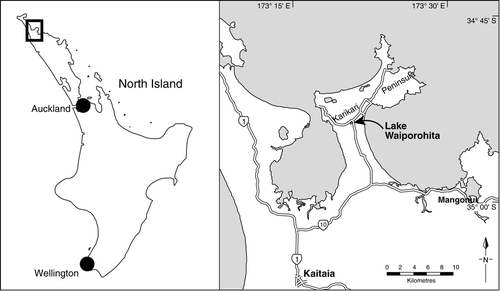Abstract
Crassula natans var. minus (Crassulaceae) is recorded for the first time from New Zealand, in the northern North Island at Lake Waiporohita, Karikari Peninsula. Native to southern Africa, this Crassula was previously known from Australasia only as a naturalized plant of Australia. Its discovery in the shoreline turf communities at Lake Waiporohita in mid November 2010 is regarded as a recent, natural dispersal event from Australia. Although Crassula natans var. minus has almost certainly naturally dispersed to New Zealand from Australia, it is regarded as naturalized to New Zealand rather than indigenous. A description of Crassula natans var. minus based on New Zealand specimens is provided.
Introduction
Lake Waiporohita (34°54′2.49′′S, 173°20′52.99′′E, 11 m a.s.l.), Karikari Peninsula, Northland, New Zealand (, ) is a botanically significant lake. In 1996, the first New Zealand record of Gratiola pedunculata was made from there by de Lange (1997) who treated that Australian species as indigenous, arguing that its sticky seeds were well suited to avian dispersal via trans-Tasman movement of water birds. The lake was also one of the first places the Australian lesser joyweed (Alternanthera denticulata) was recognized in New Zealand, as well as the type locality for nahui (Alternanthera nahui) (see Heenan & de Lange Citation2004; Heenan, de Lange & Keeling 2009).
The lake, despite its roadside proximity, is still relatively pristine. It is managed by the New Zealand Department of Conservation and has long been monitored by the National Institute of Water & Atmospheric Research (NIWA) as part of a Northland Regional Council-funded study. A range of nationally significant plants are known from there, including the threatened grass Amphibromus fluitans, naturally uncommon Centipeda aotearoana and colonizer Gratiola pedunculata (de Lange et al. Citation2009). The lake is also an important habitat for a range of aquatic birds, including several that are mostly Australian and regarded as uncommon and/or vagrant species in New Zealand (see list in de Lange Citation1997; Miskelly et al. Citation2008).
Figure 2 Shoreline of Lake Waiporohita showing the marginal turf in which Crassula natans var. minus grows.

In November 2010, during a routine inspection of the lake shore turf by the authors, numerous plants of an apparently new Crassula were discovered growing on damp bare sandy ground, amongst a short turf of mostly Glossostigma elatinoides and Myriophyllum propinquum, and nearer the lake amongst seedlings of Gratiola pedunculata and Alternanthera nahui. The plants () had small filiform stems with widely spaced patent leaves, slender pedicellate 4-merous flowers with calyces ½ to ⅔ as long as the corolla, and minute white to pink–white petals with a prominent central and basal magenta streak, and smooth follicles, each bearing a single dark brown, glossy seed 0.6–0.7 mm long. These are characters that match Crassula natans var. minus (Eck. et Zeyh.) G.D.Rowley, a south-western and southern African species of moist soil in clay pans and wetland margins that is regarded as naturalized to Australia (Toelken Citation1977, Citation1981; Toelken et al. Citation1996). In Australia, this Crassula is widely distributed through West Australia, South Australia, Victoria and Tasmania (Toelken et al. Citation1996).
Figure 3 Flowering and fruiting plants of Crassula natans var. minus. A, Plants growing on damp sand with Glossostigma elatinoides. B, Flowering and fruiting branches, note pedicellate flowering and fruiting condition, erect to erecto-patent petals each with a prominent basal abaxial magenta marking. C, Close-up of flower and leaves (note the minute apiculate leaf apices, hydathodes along the leaf margins). D, Mature follicles borne on a decurved, elongated pedicel. Scale bars (C, D) = 1 mm.

Here we provide a description of Crassula natans var. minus based on specimens collected from Lake Waiporohita, and discuss the naturalized status of this plant.
Taxonomy
Crassula natans var. minus (Eck. et Zeyh.) G.D.Rowley, The Cactus and Succulent Journal of Great Britain 40, 53 (1978)
= Helophytum natans var. minus Eckl. et Zeyh. Enumeratio Plantarum Africae Australis extratropicae qua collectae, determinatae et expositae, 288 (1836)
Description (): Glabrous, plant of semi-aquatic habitats. Branches decumbent, filiform up to 100 mm long, sparingly to much-branched. Leaves connate at base, succulent, patent and usually widely spaced, on internodes 3.3–28 mm long, lamina 3.3–7.4×0.5–1.2 mm, 0.5–0.8 mm thick, pinkish-green, pale green or red, linear to oblanceolate, dorsiventrally flattened to ± terete, with 2–3 pairs of minute dark pink hydathodes, apex obtuse or rounded, minutely apiculate, apiculus 0.1–0.3 mm long, caducous; sheath 0.3–0.5 mm long, hyaline. Flowers 4-merous, 1–2(−3) per leaf axil at successive nodes; pedicels 1.4–5.2 mm long, filiform, calyx lobes broadly triangular, 0.2–0.4 mm long, green to yellow–green, distally streaked dark crimson–red, subacute, obtuse or rounded; corolla shortly tubular, 0.3–0.6×0.4–0.6 mm, white tinged pink, petals weakly connate, erect to erecto-patent, 0.5–1.1 mm long mostly white (sometimes distally tinged pink) base prominently streaked magenta, oblanceolate, obtuse or rounded (rarely apiculate); nectary scales 0.4–0.5×0.15–0.25 mm, oblong–cuneate, truncate; stamens 4, filaments 0.1–0.25 mm long, yellow, anthers initially magenta fading to pink at anthesis; ovaries 4, initially obovoid becoming cylindric with age, each with 1 ovule. Follicles 0.49–0.82×0.32–0.60 mm, pale pink when ripe, ovoid, weakly±trigonous, smooth, spreading to strongly recurved, opening along the entire suture; fruiting pedicel elongating at fruit maturation (up to 10 mm long), usually decurved toward soil; seeds 0.6–0.7 mm long, dark brown, glossy, smooth (sometimes faintly longitudinally ridged).
Specimens seen: North Auckland: Karikari Peninsula, Lake Waiporohita, south-eastern shoreline P. J. de Lange 9341, A. J. Townsend & J. R. Rolfe, 19 Nov 2010, AK 318964; Karikari Peninsula, Lake Waiporohita, eastern shore near road P. J. de Lange 9342, A. J. Townsend & J. R. Rolfe, 19 Nov 2010, AK 318965.
Distribution and habitat: In New Zealand, C. natans var. minus has so far only been recorded from Lake Waiporohita at the junction of the Rangiputa–Inland Roads, Karikari Peninsula, Northland, North Island. It has yet to be recorded from other Northland lakes, all of which have been surveyed and monitored almost yearly since 1991 by staff working for NIWA (P. D. Champion, NIWA, pers. comm.).
At Lake Waiporohita the Crassula is common, mostly growing on damp sand in sites left bare by receding water levels, but also amongst Glossostigma elatinoides and Myriophyllum propinquum turf, and sometimes amongst Gratiola pedunculata, Alternanthera denticulata, A. nahui and Centipeda aotearoana.
Recognition: The recognition of C. natans var. minus in New Zealand brings the number of indigenous and naturalized Crassula spp. wild in New Zealand to 30 (cf. de Lange et al. Citation2005, 2008; Sykes Citation2005; Heenan et al. Citation2008). Crassula natans var. minus is easily distinguished from these other species by the long internodes; linear to oblanceolate, obtuse or rounded (minutely apiculate) patent leaves; pedicellate flowers and fruits; magenta-tipped calyx lobes, white or pink-tinged flowers with erect to erecto-patent petals with the petal bases prominently streaked magenta, and by the 1-seeded follicles. Crassula natans var. minus is a member of Sect. Helophytum (Eckl. et Zeyh.) Toelken and it is most similar to three of the indigenous New Zealand representatives of that section, C. peduncularis (Sm.) F.Meigen, C. ruamahanga A.P.Druce and C. sinclairii (Hook.f.) A.P.Druce et Given. Of the three, C. natans var. minus is mostly likely to be confused with the indigenous C. peduncularis which occupies similar habitats in the southern North Island, throughout the eastern South Island, and at Mason Bay, Stewart Island (Heenan et al. Citation2009; de Lange et al. 2010), but which is not yet known from the northern North Island. Both species have an annual growth habit, the plants are often reddish or pink-tinged, and they both have distinctly pedicellate flowers and fruits, the pedicels elongate greatly after flowering. However, C. peduncularis differs from C. natans var. minus by the linear to linear–lanceolate acute leaves, flowers with elliptic–ovate petals, and by the follicles which bear 10 or more, orange–brown, elliptic–oblong, 0.2–0.35-mm long seeds (Sykes Citation2005; de Lange et al. Citation2010). Crassula natans var. minus also has a superficial similarity to C. ruamahanga and C. sinclairii, two endemic species of Sect. Helophytum which occupy similar wetland habitats throughout New Zealand. Crassula ruamahanga (see de Lange et al. Citation2008) shares with C. natans var. minus the same decumbent, widely creeping growth habit, and paired leaves held on widely spaced internodes. However, it is a yellow–green to dark green, heavily branched perennial, rather than pinkish-green annual plant, with smaller leaves (0.7–2.9×0.3–1 mm, cf. 3.3–7.4×0.5–1.2 mm in C. natans var. minus); and linear–oblong, linear–lanceolate, lanceolate or elliptic–lanceolate leaves, with subacute, acute to sharply acute (rarely obtuse) apices (not linear to oblanceolate, obtuse or rounded). Both species may have an apiculate apex, and in both the apiculus is caducous and of a comparable length (0.3 mm in C. ruamahanga, 0.1–0.3 mm in C. natans var. minus). However, the flowers of C. ruamahanga though pedicellate, are usually only shortly so (very rarely up to 5.4 mm long) and when fruiting, the pedicels do not elongate as much as they do in C. natans var. minus. Critically, the petals are spreading (not erect), so imparting a ‘star-like’ appearance when viewed from above (see Sykes Citation2005); and the petals are narrowly elliptic–ovate, ovate to triangular–ovate with sharply acute to acute apices, and uniformly white or pinkish white. By contrast, the corolla lobes of C. natans var. minus are erect to erecto-patent (so not ‘star-like’ sensu Sykes Citation2005), oblanceolate, mostly obtuse or rounded (rarely subacute) and prominently streaked with magenta near the base. Confusion with C. sinclairii is less likely as this is a much smaller, moss-like perennial plant with smaller (0.5–2.0×0.2–0.5 mm, cf. 3.3–7.4×0.5–1.2 mm in C. natans var. minus) acute-tipped leaves, subsessile ‘star-like’ flowers with spreading rather than erect petals, and smaller orange–brown to red–brown seeds (0.3–0.45 mm long, cf. 0.6–0.7 mm long in C. natans var. minus).
Biostatus: Crassula natans var. minus is native to south-west southern Africa and regarded as naturalized to Australia (Toelken et al. Citation1996). Its occurrence at Lake Waiporohita appears to be ‘recent’ as it was not observed at this lake in October 2009 by PdL and JRR, or during surveys by NIWA scientists over the last decade (P. D. Champion, NIWA, pers. comm.). It is also absent from gatherings made from this lake and others nearby by A. E. Esler and G. B. Rawlings in 1970 and 1974. Lake Waiporohita is an important lake for a range of water birds shared with Australia (de Lange 1997), many of which are regarded as trans-Tasman vagrants to New Zealand (e.g. white-necked heron, Ardea pacifica, white ibis, Threskiornis molucca, yellow-billed spoonbill, Platalea flavipes, white-eyed duck, Aythya australis australis, and chestnut breasted shelduck, Tardorna tardornoides) or birds known to fly frequently between both countries (e.g. grey teal, Anas gracilis) (R. A. Pierce, pers. comm.). Previously, de Lange (1997) reasoned that such birds were the likely seed vector for Gratiola pedunculata, while the recent discovery at Lake Waiporohita, of the Australian–New Caledonian rush Juncus polyanthemus Buchenau (itself probably another recent natural arrival, and in this case, indigenous to New Zealand), is also believed to be the result of trans-Tasman bird movement (P. D. Champion, NIWA, pers. comm.). We suspect that the same is true for C. natans var. minus, whose frequency in shallow ponds, lakes, dams, rock pools and seasonally flooded clay pans in Australia (Toelken et al. Citation1996), makes it susceptible to being moved by dabbling birds such as ducks.
Whether C. natans var. minus should be regarded as indigenous to New Zealand because it arrived by ‘natural’ means is easily resolved. The plant is not indigenous to Australia and so the New Zealand occurrence, which most probably originates from Australia rather than southern Africa, means that New Zealand plants should also be regarded as naturalized.
This view differs from that offered in Flora IV where it was argued that Kaitaia occurrences of Pittosporum undulatum could possibly be considered indigenous (Webb et al. Citation1988). The reasoning was that P. undulatum most probably arrived naturally via bird movement from Norfolk Island where it has been introduced and is now naturalized (Green Citation1994). We see no reason to support the notion that natural arrivals of plants from nearby landmasses where they are indisputably naturalized automatically accords them indigenous status here. In any case Pittosporum undulatum is now, rightly in our view, regarded as fully naturalized in New Zealand (Heenan et al. Citation2002).
As regards the potential impact of C. natans var. minus in New Zealand turf communities, it is too early to say what effect this plant may have. However, plants appear to grow rapidly, seed prolifically and it is likely that they will smother other smaller turf plants. Although we have been unable to find any literature to determine if C. natans var. minus is a threat to the turf flora of Australian wetlands, we feel that as a precautionary measure further study into the potential impact of C. natans var. minus in New Zealand is urgently needed.
Acknowledgements
The authors would like to thank Paul Champion, Rhys Gardner, Don Newman, Colin Ogle, Hugh Robertson and Hellmut Toelken for their helpful comments on a draft of this paper.
References
- de Lange , PJ . 1997 . Gratiola pedunculata (Scrophulariacae): a new addition to the New Zealand flora . New Zealand Journal of Botany , 35 : 317 – 322 .
- de Lange , PJ , de Lange , TJP and de Lange , FJT . 2005 . New exotic plant records, and range extensions for naturalised plants, in the northern North Island, New Zealand . Auckland Botanical Society Journal , 60 : 130 – 147 .
- de Lange , PJ , Heenan , PB , Keeling , DJ , Murray , BG , Smissen , R and Sykes , WR . 2008 . Biosystematics and conservation: a case study with two enigmatic and uncommon species of Crassula from New Zealand . Annals of Botany , 101 : 881 – 899 .
- de Lange PJ , Heenan PB , Norton DA , Rolfe JR , Sawyer JWD 2010 . Threatened plants of New Zealand . Christchurch, Canterbury University Press .
- de Lange , PJ , Norton , DA , Courtney , SP , Heenan , PB , Barkla , JW , Cameron , EK , Hitchmough , R and Townsend , AJ . 2009 . Threatened and uncommon plants of New Zealand (1998 revision) . New Zealand Journal of Botany , 47 : 61 – 96 .
- Green PS 1994 . Flora of Australia. Volume 49. Oceanic Islands 1. Canberra, Australian Government Publishing Service .
- Heenan , PB and de Lange , PJ . 2004 . Alternanthera denticulata (Amaranthaceae) in New Zealand: a new addition to the indigenous or naturalised flora? . New Zealand Journal of Botany , 42 : 739 – 745 .
- Heenan , PB , de Lange , PJ , Cameron , EK and Champion , PD . 2002 . Checklist of dicotyledons, gymnosperms, and pteridophytes naturalised or casual in New Zealand: additional records 1999–2000 . New Zealand Journal of Botany , 40 : 155 – 174 .
- Heenan , PB , de Lange , PJ , Cameron , EK and Parris , BS . 2008 . Checklist of dicotyledons, gymnosperms, and pteridophytes naturalised or casual in New Zealand: additional records 2004–06 . New Zealand Journal of Botany , 46 : 257 – 283 .
- Heenan , PB , de Lange , PJ and Keeling , JK . 2009 . Alternanthera nahui – a new species of Amaranthaceae indigenous to New Zealand . New Zealand Journal of Botany , 47 : 97 – 105 .
- Heenan , PB , de Lange , PJ , Rance , BD , Sykes , WR , Meurk , CD and Korver , MA . 2009 . Additional records of indigenous and naturalised plants and observations on the distribution of Gunnera tinctoria on Stewart Island, New Zealand . New Zealand Journal of Botany , 47 : 1 – 7 .
- Miskelly , CM , Dowding , JE , Elliot , GP , Hitchmough , RA , Powlesland , RG , Robertson , HA , Sagar , PM , Scofield , RP and Taylor , GA . 2008 . Conservation status of New Zealand birds, 2008 . Notornis , 55 : 117 – 135 .
- Sykes , WR . 2005 . Notes on Euphorbia and Crassula with a revised key to the latter wild in New Zealand . New Zealand Botanical Society Newsletter , 79 : 8 – 16 .
- Toelken HR 1977 . A revision of the genus Crassula in southern Africa. Contributions of the Bolus Herbarium 8 . Bolus Herbarium, University of Cape Town, Republic of South Africa .
- Toelken , HR . 1981 . The species of Crassula L. in Australia . Journal of the Adelaide Botanic Gardens , 3 : 57 – 90 .
- Toelken HR , Jeanes JA , Stajsic V 1996 . Crassula . In : Walsh NG , Entwisle TJ Flora of Victoria. Volume 3. Melbourne, Inkata Press . Pp. 542 – 551 .
- Webb CJ , Sykes WR , Garnock-Jones PJ 1988 . Flora of New Zealand . Vol. IV. Christchurch, Botany Division, DSIR .
